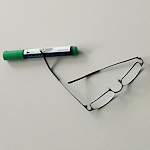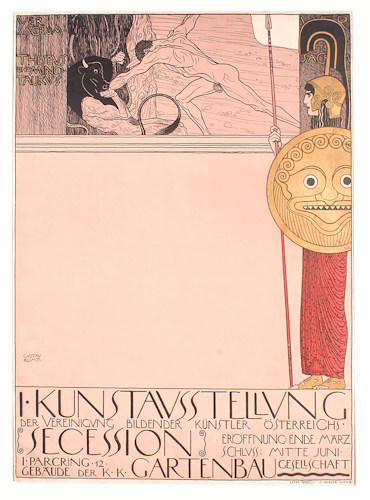
Just when you thought every aspect of Gustav Klimt had been examined in public detail, the MAK museum surprises us. The Teaching Klimt exhibition connects Klimt’s style and works with his education at the Vienna School of Arts and Crafts
- Highlights important teachers and themes in Klimt’s early development
- Includes around 180 items (18 from Klimt)
- Gorgeous examples of early Klimt works
- All info in English and German
- Runs Nov 3, 2021 – Mar 13, 2022
- See also:
- Current MAK exhibition & ticket info
- Art exhibitions in Vienna
- Klimt’s footsteps
An educational journey

(Gustav Klimt, Poster for the 1st art exhibition of the Union of Austrian Artists – Secession, Vienna, 1898; Commissioner: Union of Austrian Artists – Secession; Print: Albert Berger, Vienna; Lithography MAK, PI 1658; photo © MAK)
A lot of exhibitions like to trace the evolution of an artist’s style. Few travel further back to a time when the artist found themselves immersed in impressions and academic lessons that would leave a lasting influence on their professional development.
The MAK’s Teaching Klimt: Studies at the School of Arts and Crafts exhibition provides a notable exception.
We all fall over ourselves to admire and laud those Klimt works that have entered the pantheon of great art. But a look at his educational roots reveals connections to those same paintings we might otherwise miss.
Guest curator Otmar Rychlik uses Teaching Klimt to reveal, particularly, the influence of those who taught Klimt while he attended the School of Arts and Crafts (today’s University of Applied Arts Vienna) and how this contributed to his emergence as a pillar of Vienna Modernism.
The school first opened in 1867 and enjoyed associations with many grand names in Austrian art and design: Josef Hoffmann (subject of another 2021/2022 exhibition in Vienna) and Koloman Moser both taught there, for example.
By coincidence, the school enjoyed a close affiliation with the k. k. Österreichischen Museums für Kunst und Industrie: the predecessor of the MAK, who host the Teaching Klimt exhibition.
The exhibition features those teacher artists who exerted the greatest influence over Klimt in different thematic areas, such as portrayal of motifs from nature, and identifies parallels to his works.
Teaching Klimt illustrates these themes with the art produced both by the teachers and Klimt himself, showcasing some of the great man’s material from the very earliest days of his career (much of which might surprise those more familiar with his later works).
We discover, for example, how the white blooms in Klimt’s portrait of Sonja Knips echo Friedrich Sturm’s flower paintings.
And you can imagine how Klimt’s Portrait of Adele Bloch-Bauer I, riven through with gold, echoes Michael Rieser’s use of that colour in religious images. The parallels become implicit when you see, for example, Rieser’s 1882 design for the high altar mosaic of the Schottenkirche church.
Klimt’s precise mastery of detail owes much to Rieser’s teaching, as well as that of Ferdinand Laufberger, who was Klimt’s professor and head of the school for many years.
As a bookworm and history aficionado, three standout exhibits are:
- Klimt’s 1889 watercolour female nude with laurel wreath from a homage to Karl von Hasenauer. Absolutely gorgeous
- Josef von Storck’s 1889 book design celebrating the 25th anniversary of the Imperial Royal Austrian Museum of Art and Industry: all glorious embossed silver, enamel, stone, and silk
- Klimt’s school report from the 1877/78 academic year. Not the rebel you might imagine: the dominant themes on the report are “very hardworking” and “excellent”.
Teaching Klimt also offers insights into other artists who served as inspiration for Klimt and perhaps drew him away from more traditional approaches to art: the likes of the German painter, Anselm von Feuerbach.
Although only one gallery, the displays shine a light on a rare aspect of the Klimt biography, adding a rather nice holistic and historical perspective to his story.
Tickets and dates
Trace Klimt’s influences from November 3rd, 2021 to March 13th, 2022. A simple ticket to the MAK gets you into the exhibition, too.
Themes are presented in wall text (in German and English). Be sure to pick up a folder, though, since this has information on each of the individual works on display (also in two languages).
For more Klimt in Vienna, see this guide. It reveals where to see his works and where to find landmarks of his life in the city.
How to get to the exhibition
Follow the tips at the end of the main MAK page to find the museum. Drop down to the lower floor; Teaching Klimt occupies the central space between the DESIGN LAB permanent areas.
Address: Stubenring 5, 1010 Vienna